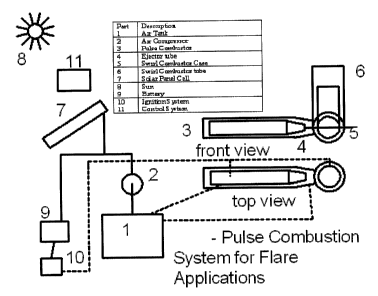Some of the information on this Web page has been provided by external sources. The Government of Canada is not responsible for the accuracy, reliability or currency of the information supplied by external sources. Users wishing to rely upon this information should consult directly with the source of the information. Content provided by external sources is not subject to official languages, privacy and accessibility requirements.
Any discrepancies in the text and image of the Claims and Abstract are due to differing posting times. Text of the Claims and Abstract are posted:
| (12) Patent Application: | (11) CA 2450485 |
|---|---|
| (54) English Title: | PULSE COMBUSTOR SYSTEM FOR GAS FLARE STACK REPLACEMENT |
| (54) French Title: | SYSTEME DE COMBUSTION PULSEE POUR REMPLACER UNE TORCHERE |
| Status: | Dead |
| (51) International Patent Classification (IPC): |
|
|---|---|
| (72) Inventors : |
|
| (73) Owners : |
|
| (71) Applicants : |
|
| (74) Agent: | |
| (74) Associate agent: | |
| (45) Issued: | |
| (22) Filed Date: | 2003-11-17 |
| (41) Open to Public Inspection: | 2005-05-17 |
| Availability of licence: | N/A |
| (25) Language of filing: | English |
| Patent Cooperation Treaty (PCT): | No |
|---|
| (30) Application Priority Data: | None |
|---|
The invention provides a unique, detailed method of burning gaseous fuels
from oil/ gas fields or landfills replacing existing gas flare stack systems.
The invention mainly consists of an aerovalved pulse-combustor that
promote the flow of air and hot combustion gases to a swirl-combustor that
burn more fuel in the system. A photovoltaic solar system or a
thermoelectric system produces electricity that charges a small battery that
supplies energy to an ignition system. The electrical power is also used to
drive an electrical motor that drives a small compressor that keeps an air
pressurized tank full. Both the ignition and compressed air are only briefly
active at the beginning of the ignition phase of the system. The only
moving part is the electrical-motor compressor that is only activated when
the air tank is not full.
Note: Claims are shown in the official language in which they were submitted.
Note: Descriptions are shown in the official language in which they were submitted.

For a clearer understanding of the status of the application/patent presented on this page, the site Disclaimer , as well as the definitions for Patent , Administrative Status , Maintenance Fee and Payment History should be consulted.
| Title | Date |
|---|---|
| Forecasted Issue Date | Unavailable |
| (22) Filed | 2003-11-17 |
| (41) Open to Public Inspection | 2005-05-17 |
| Dead Application | 2006-11-17 |
| Abandonment Date | Reason | Reinstatement Date |
|---|---|---|
| 2005-11-17 | FAILURE TO PAY APPLICATION MAINTENANCE FEE |
| Fee Type | Anniversary Year | Due Date | Amount Paid | Paid Date |
|---|---|---|---|---|
| Application Fee | $150.00 | 2003-11-17 |
Note: Records showing the ownership history in alphabetical order.
| Current Owners on Record |
|---|
| FERNANDES, LUIZ CLAUDIO VIEIRA |
| Past Owners on Record |
|---|
| None |